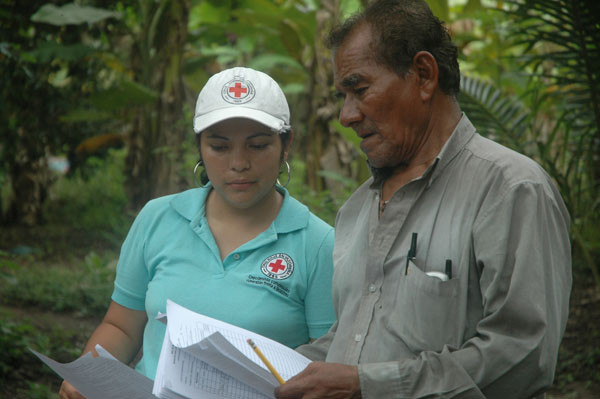Building communities more resilient to disasters in Guatemala
Pedro Cancuc, a 45-year old community leader, lives in the small community of Chapín Arriba Las Machacas in Guatemala. He lives in this rural community with his wife and daughters and remembers when there was nothing 32 years ago when he first arrived.
“Our community is divided by a river’s channel. Before we did not have a bridge to cross the river, especially during the rainy season, and it was very dangerous for the children. It was difficult for them to go school. Therefore, the children missed classes in order to avoid drowning or being dragged by the river when crossing it swimming or walking, posing a serious security risk.”
“The Guatemalan Red Cross helped us to build a bridge that connects our community, they trained us in first aid and spoke us about the importance of hygiene care and how it can affect the health of the community as a whole” says Pedro Cancuc, community leader.
The integrated disaster risk reduction activities, implemented by the Guatemalan Red Cross, are supported by the International Federation of the Red Cross and Red Crescent Societies through the work developed by the Federation’s Regional Reference Centres in Disaster Risk Reduction, improving the quality of the topics carried at the community level.
“The use of the AVC methodology Learning by Doing has helped all of us by teaching the importance of using a participative approach in mapping resources and identifying community- based needs. This approach takes into account the opinions of community members from the beginning of the process, helping to organize the information and making it easier to take more realistic and viable decisions”, highlights Edy Leal, National DFID Project Coordinator and Guatemalan Red Cross volunteer.
The coordination with key partners was an important element in the implementation of the actions. Several partners were involved such as the Finnish Red Cross, providing both technical and financial support. Coordination with the local Municipality and the National Government was also established during the implementation process.
“An innovative and environmentally-friendly approach used was the installation of solar panels in the schools because many of them did not have energy. Now, there is light in the schools and the teachers, children and parents are very happy” says Rolando Gutiérrez, a volunteer from the Santo Tomas de Castilla Red Cross branch.
“The first to respond in a disaster is the community itself, therefore the success of the response to a disaster depends on the communities´ capacity and ability to coordinate effectively between the affected areas, the Red Cross, other institutions and local humanitarian actors” says Roy Venegas, Regional Disaster Risk Reduction Project Coordinator.
“Thanks to these mitigation and capacity building actions we feel safer, especially our children, and we can now cross the bridge without fear. The People can go to work, go to school and carry on with their daily lives, even during the rainy season when the river is full.”

Photo: © IFRC
“It has helped our community to be more organized and we feel better prepared in case of disaster. We trust the Guatemalan Red Cross because they promised to help us and they did. Hopefully, they will not leave us alone since we need to continue learning and strengthening our capacities in many other topics like how to prevent diseases and other health related issues” says Pedro Cancuc.
According to the 2007 World Disaster Report, thousands of lives and billions of dollars could be saved every year if a fraction of the funds spent on responding to catastrophes went towards minimizing the effects of natural disasters on vulnerable people. Studies by the World Bank, for example, have shown that every dollar invested in risk reduction can save between two and ten dollars in disaster response and recovery costs.
The financial contribution of the Department for International Development of the British Government (DFID) aims at strengthening capacities in disaster risk reduction at institutional and community level.
|